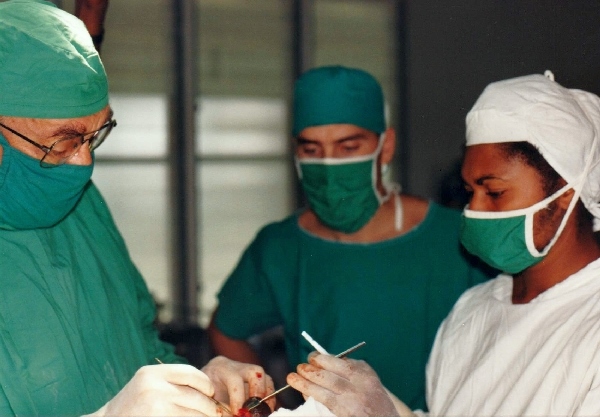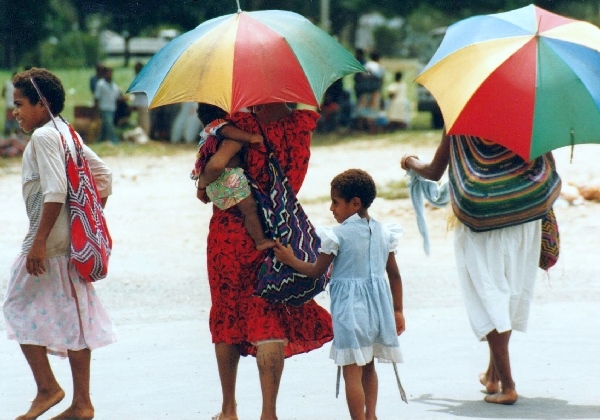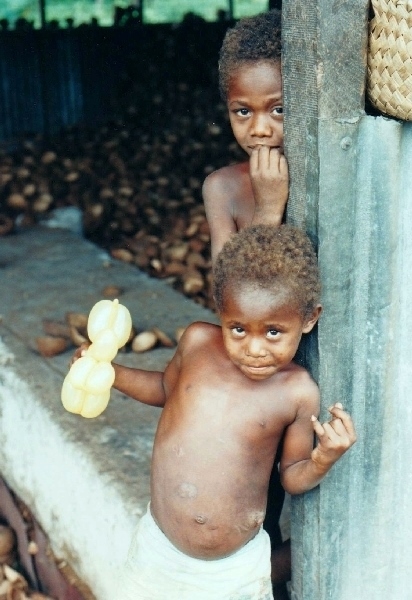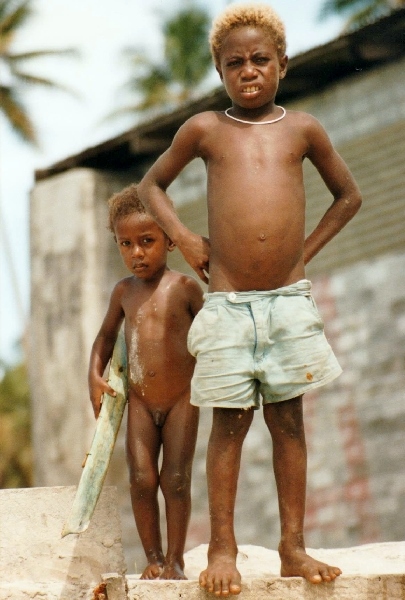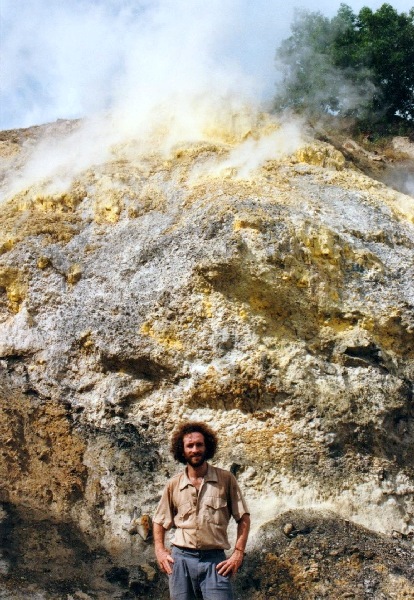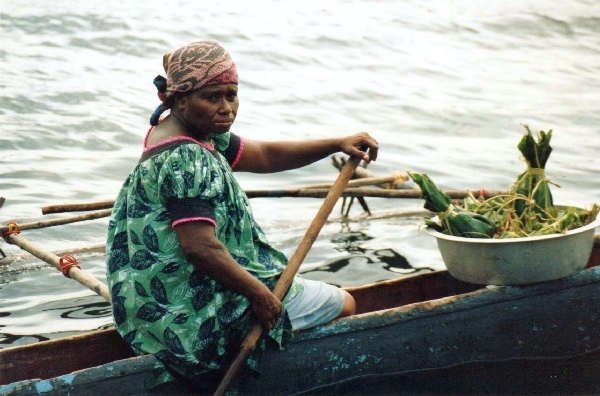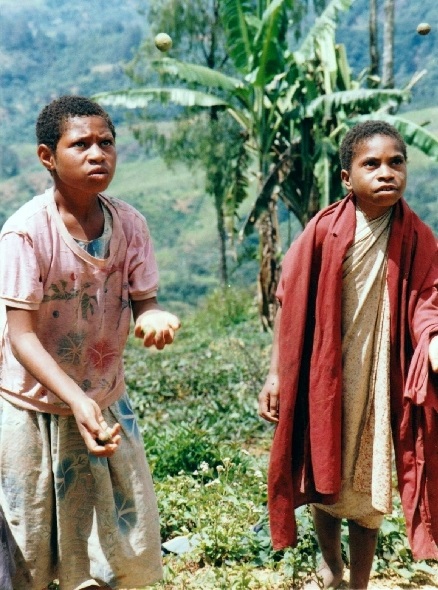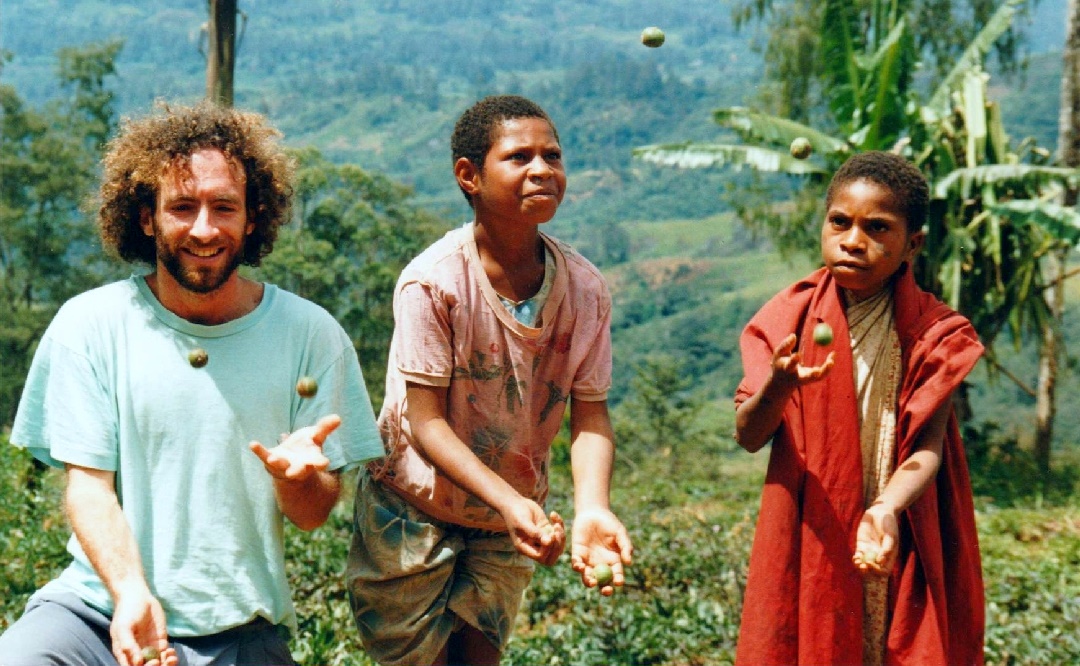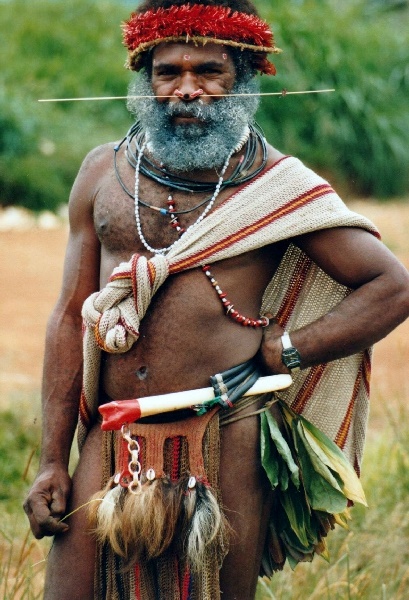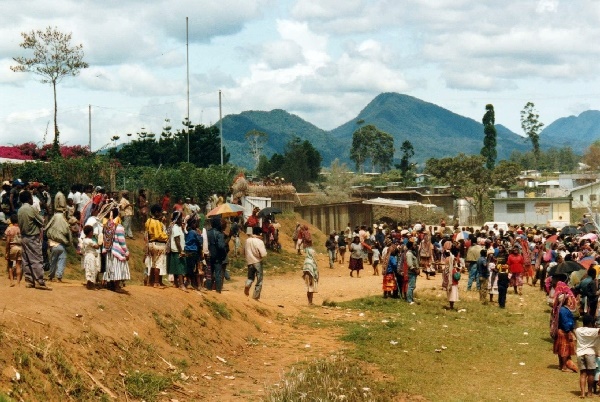World traveler Clown Tom Bolton
Adventure stories & photos

Tom’s travels to Papua New Guinea – PNG
Arrival in Vunepope, New Britain Island, PNG
Papua New Guinea also known as PNG is simply a crazy place! It’s a group of islands north of Australia whose inhabitants, like the Australian Aborigines, migrated there from Africa at least 50,000 years ago. Many coastal tribes have long had contact to seafaring foreigners but none of the remote highland tribes even knew of, or were known to, the outside world until the 1920’s when westerners ventured there looking for gold. The mountains and jungles are rugged and the tribes practiced ritual warfare and cannibalism. There were still tribes making first contact in the 1970’s and rumors persist of uncontacted groups but this seems rather unlikely. It’s wildly beautiful but a dangerous place whose inhabitants practice a mixture of beliefs and customs out of the Stone Age thrown into the modern world.
Catholic mission & hospital in Vunepope
In 1992 I spent 6 weeks there traveling and also visiting my sister doctor Kate Bolton who was a medical missionary at the Catholic mission in Vunepope, on the island of New Britain. I actually stayed at the mission house for the nurses, which was surely a bit questionable for the nuns and priests. What might have been even more shocking was for the locals to hear from my sister that her brother was visiting. Even in PNG there was a taboo against incest, which in their culture meant that brothers and sisters had no contact with each other upon reaching adulthood. I dedicate this page to my sister Kate who tragically died of ovarian cancer in 2015. In addition to her work in Papua New Guinea, she volunteered for projects in Asia, Africa and Latin America. I secondly dedicate this to Dr. Tomer Levy who is pictured together with Kate. He was a dedicated soul who died in an accident in a return trip to Vunepope in 1996.
The actual medical staff was all dedicated volunteers who had to deal with working with very limited supplies and equipment while coping with a wide range of problems beyond their specialties. As my sister put it, it’s not a question IF they have malaria, anemia, meningitis or a host of other ailments but WHICH is the critical problem at the moment. The Australians had administered the Islands after WWI until independence in 1975 and had left a legacy of civil structures including a system of hospitals and clinics, which was in the process of collapsing due to malfeasance. As simple as this medical facility was, usually running with just 3 or 4 doctors and a handful of nurses, it was at the time possibly the best in the country.
Here I am below left in the op in the mission hospital, my siter Kate below right. Short scrub pants and bare feet were normal due to the always hot, humid weather. I got to see a number of operations and observe both the last breaths of a dying man and the first breaths of a new born baby, moving experiences to see the full circle of life. I only observed of course but I think the locals assumed that any westerner there was probably a doctor.
Performing at Vunepope Mission
Of course I did some performances for the people at the mission in Vunepope. The one scene I am entertaining the nuns, most of whom worked assisting the medical staff or the running of the mission. The other scene is me doing a show for patients and/or local workers and their children. Who ever was around was welcome.
Santa Claus rides in a helicopter
It was Christmas time when I arrived in Papua New Guinea and of course they celebrated it at the Catholic mission. People didn’t have chimneys for Santa to come down and nobody would know a reindeer from a cow, so in PNG Santa Claus comes in a helicopter to bring toys to the sick kids in the hospital. I contributed a little show of my own and even got a Christmas meal and 25 Kinas for performing at a private dining club where many of the westerners went to in Rabaul the nearest sizable town and capital of New Britain Island.
Papua New Guinea national airlines: Air Niugini
I didn’t fly in the helicopter but did take a couple of flights on the national airlines Air Niugini which is a vital asset in such a country with rugged terrain and few roads; boats and aircraft surely outweighed land vehicles in importance. I actually flew in and out of the country through the international airport by the capital of Port Moresby but literally took the first flight on to Rabaul rather than go into the town. Later I flew from Rabaul to Madang and from Hagen in the Highlands back to the capital.
Locals on the coast
We stopped to see some of the locals by the beach near the mission. Although most of the people around had at least an indirect job or connection to the mission, meeting any new foreigners still seemed to be an exciting event for the kids which here got the universal seal of approval with a “thumbs up”.
Simple lifestyles, fishing, betel nut, facial tattoos
Many of these families lived from fishing and lived in pretty basic shacks made of scrap. Not as quaint as the traditional construction but probably more durable. It also takes much less time to put up some plywood sheets than cutting down trees and weaving leaf and thatch for walls and roofs. Women like men often chewed betel nut, which stains the teeth a dark red. Most women wore the African style dresses introduced by western missionaries. Interesting here is the woman’s tattoos. Like in New Zealand, traditional tattoos were also done on the face and in PNG not just by the men!
Performance in prison
We visited a prison where I made a show for these kids of the workers. Yeah, they lived and grew up within the prison compound surrounded by barbed wire. I guess that’s what one calls a “captured audience”. I have no idea how much time and freedom they had outside of the prison but it seemed like a potentially dark existence. It certainly was one of my more bizarre performing venues.
Markets; places for shopping & social contact
Although stores do exist in the bigger towns, the main transfers of commodities are at the local markets. Here I made a show for people at the weekly market in Rabaul, which at the time was the capital of New Britain, the second biggest island in the country. I also performed at the market in Kokopo, which was the closest real village to the Vunepope mission. These were typical market scenes in Papua New Guinea.

Markets reflect advanced agriculture
In addition to recognizable foods like carrots and bananas there were a number of indigenous plants, the most important before the introduction of the sweet potatoes was a tubular called taro. Anthropologists have suggested that due to its advanced agriculture, the highland cultures of PNG were the highest level of human civilization 10,000 years ago. Although they never developed metal, there were an estimated 2 million people living in the highlands of the main island of New Guinea, with a long history of established codes of social interaction
Pidgin and local languages
The sign below left had paintings of foods listing their pidgin names. As every tribe has its own language, adopting a simplified form of English, with some German and Dutch thrown in, makes inter-tribal communication possible and is seen as an official language on its own in addition to formal English which is used by the highly educated and governmental officials. Learning Pidgin is not as straightforward as one might think but most people who stay there for a while find it worth putting some effort into. The sign to the right was in both pidgin and english. Good thing as a English speaker probably wouldn’t catch the seiousness of this message.
Basket weaving, beating the heat
Many baskets and bags were woven out of palm like leaves. Not just useful for holding things, one could use such a bag for protection against the intense sunrays. Even in the highlands, the days were hot! Not nearly as common, making a hat out of bananas also worked. The other method to beat the ever present heat was to enjoy a frozen desert. I think most such treats were water rather than milk based due to sanitary considerations and local taste.
Evangelism at the markets
The markets were always a social event and often a place where such Christian groups would present a musical program in their evangelical attempts. The opportunity to convert “godless heathens” that were once headhunting cannibals seemed to draw lots of Christian fundamentalist fanatics to PNG. Many were obsessed with suppressing much of the local culture claiming it was against God. I was impressed by the Catholics’ efforts there however.
The emphasis seemed to be to first help the locals in matters of health, education and development while respecting their culture rather than beating them over the head with a bible. I once met a priest dressed up in wild local costume to participate in a cultural ceremony, something that most fundamentalists would have deemed satanic. And the locals’ readiness to accept western religions appeared to depend less on spirituality than on hoping to obtain wealth. The white people were so wealthy so their gods must be pretty powerful, so why not tap into a piece of that action.
Handcrafted bags & long cigarettes
I saw these women just outside of a market. The bags they use are very strong and beautifully made pieces of handicraft. Most of the weight is carried by the head, while leaving the hands free. I thought of buying one but they were very expensive. The other thing of note is the cigarette being smoked. In Papua New Guniea tobacco was rolled in a sheet of paper, often in newspaper, resulting in cigarettes of comical lengths.
Visit to Duke of York Islands plantation
My sister had connections to a large plantation on the nearby Duke of York Islands that belonged to the Catholic missions and had originally been founded by the German Imperial Empire. Here they grew and processed coconuts and as seen below, cacao which was being cut open by a worker. Such places employed a lot of locals, but they couldn’t tell people exactly when payday was or some of the local bandits, known as rascals, would try to steal the payroll. Such criminality was a major problem throughout the country. Typically a rascal would be the guy who sat next to you at the church service on Sunday morning bemoaning the level of crime in the community. Then by night he and his friends would be robbing and pillaging.
The children there were the offspring of of the plantation workers. Here they dried the coconuts producing what is known as copra and processed the husks and shells.
Agriculture done on small plots
Most agriculture in PNG is still done on small family plots. These larger plantations equipped with farm machinery like tractors are really the exception but earn hard cash and money wages for the employees. But the wages were very low when one considered the prices for anything but the most basic things. Due to low world prices for such agricultural commodities, most such places were struggling for survival and were usually run by a religious or charity organization with the emphasis on keeping people employed.
Danger of robbery in Papua New Guinea
But trying to aid the people in PNG was difficult. Typically, a charity would build a school for a village and the people in the next village would be jealous and destroy it. Or the village inhabitants would suddenly claim that the charity needed to pay them millions of dollars compensation or they would destroy their own school! Westerners, especially the mining companies, were constant targets for outrageous extortion attempts or robbery by the locals throughout the country. While I never got robbed myself, I was very cautious, never going out after dark but it was almost comical how I heard of places that got robbed just before I arrived or just after I left. In one such incident they even caught the rascals who had broken into the Rabaul dining club, got completely drunk, and then tried to hitchhike home with 25 cases of stolen beer.
Blond hair from foreign interbreeding?
A group of boys by the plantation were playing with a mandolin. One occasionally saw coastal people in Papua New Guineawith such blond hair, possibly having some German blood in them. The Germans had colonized this part of New Britain Island and many of the nearby ones as well in the 1880’s but malaria and stress with the locals plagued them and the Aussies finally drove them out during WWI. Clothing was optional for the kids but adults in some remote places still didn’t wear more than some string or grass to protect their lower genitals.
Sightseeing: volcanoes, Japanese war remains
That’s my sister and me in the smoldering crater of one of the many active volcanoes near Rabaul. Rabaul had been annihilated by eruptions in 1937 but they keep rebuilding it. It was heavily damaged once again by a major eruption in 1994, which buried it under 2 meters of ash. Many nearby towns were also destroyed displacing at least 90,000 people. Some crazy people are still living there in the ruins although basic services are no longer available and it is only a matter of time before it gets blasted again. At first I wondered to myself why people would live right by a bunch of live volcanoes but with boat transportation being so important, when westerns came to the area they picked the spot with the best-protected deep-water harbor thus the founding of Rabaul.
Scuba diving & snorkeling
I also visited the volcano research and observation post in the hills above Rabaul and remember thinking I had never seen a more lush and beautiful jungle view. And the abundance of coral and fish makes PNG the ultimate spot in the whole world for scuba diving. Most of the clinic staff including my sister became avid divers. I only snorkeled since it is high risk for asthmatics but even then saw many fish one only expects to ever see in an aquarium or in National Geographic like lionfish, clown fish etc. Like many aspects of Papua New Guinea, what was to be found in the water was beautiful but also potentially very dangerous.
Malaria & other natural dangers
One volunteer nurse there came down with malaria within weeks of arriving and later something poisonous in the water scratched or bit her. The initial wound was minor but within days her leg looked like something out of a horror movie and she had to be flown to Australia for better medical treatment. I was warned not to step on a stonefish. The poison can leave permanent neurological damages and is said to be the most painful thing a human body can experience. Although not usually fatal many victims prefer it were rather than to survive the horrendous suffering. I saw plenty of sea snakes, which I heard were too small to manage a bite to a human except maybe to the webbing between your fingers or toes. Not sure if this is true but although their venom is highly potent, few people seem to die from their bites since most species are not aggressive and the amount of venom they inject seems to be minimal.
Japanese occupation & warplanes
Here I am on top of the relic of a WWII Japanese warplane. The Japanese had invaded PNG and used Rabaul as their headquarters. When locals fought them, the Australian press labelled them “black angles”. They didn’t necessarily care about assisting the westerners but being warriors they weren’t going to let the Japanese occupy them either. The Aussies eventually drove the Japanese out during WWII but many such wrecks and bomb craters are still to be found in the area. There were some extensive tunnels near this spot, which had been drilled into the stone by the Japanese to hide out in. I heard that a number of nuns had been attacked and raped there recently. In another village a teacher who might also have been a nun was decapitated as payback for having given a kid a bad grade.
Kokopo harbor
Here were just some dudes hanging out on their boat in the Kokopo harbor near Vunepope. I hear it has become the main hub for transportation in the area after the volcano destroyed Rabaul. Despite the local importance of Vunepope, the catholic mission basically gave up sending westerners there after over a hundred years of history, including being occupied and used as an internment camp by the Japanese during WWII. It wasn’t the continued risk of volcanic eruption but the rising level of violence in the country that sealed its fate.
Outrigger canoes common
Bigger boats were used for commerce but many families relied on their outrigger canoe to get around or to transport things to and from the local market.
Siar Island & Highlands of New Guinea Island
After visiting New Britain Island, I flew to Madang on the north coast of New Guinea the main island of Papua. I first stayed at a Catholic seminary, which took me in due to my sister’s connections, the bishop there having been treated by her before. Getting up at 4 a.m. to chant prayers was a bit much for me but luckily I found a laid back place on a small nearby island called Siar.
Most people traveling in PNG are missionaries who network amongst themselves or are government workers or mining employees who have a budget to pay for accommodation which is often hundreds of dollars a night. Backpackers are almost unheard of and cheap rooms are few and far between. On Siar I had a simple hut by the beach for a couple of days . I had heard that Simon the local owner didn’t provide much food for his guests but I got feed OK. The atmosphere was very relaxed but I got restless as otherthan the kids playing on teh ceach and the boats thre, nobody was around. I probably would have stayed longer if there had been some other tourists to hang out with. From Siar Island I ot a boat back top Madang and headed up to the highland towns of Goroka, Hagen, Mendi and Tari.
Performing in Goroko, Papua New Guinea Highlands
I visited a missionary family in Goroko who were known to my sister. I made a show by the market place and promised to return in a few hours. When I came back there were about 2000 people waiting for me. People totally freaked out when I vanished a small red handkerchief. I stopped doing any magic there since any bad occurrences would be blamed on sorcery and the disaffected party would look to get revenge.
I heard that if an employee from any of the mining companies involved in Papua New Guinea so much as ran over somebody’s chicken, their whole family might be quickly airlifted out before they literally lost their heads. So if anybody who watched my show became ill or something bad happened soon afterwards, they might connect it to me and take revenge against the family I stayed with. So is the craziness of Papua New Guinea
Despite these factors or maybe partially because of them, it was always a very intense situation to perform. I once an across a website from some Europeans that had also made shows around PNG. They presented this picture of happy, friendly, carefree natives welcoming them at every turn. I think there were probably many forces in play around them that they were simply never aware of and maybe they were happier not to know but I found their idealized accounts to be fantastically naive.
Juggling in PNG highlands; teaching, performing
I met these girls in the highlands of PNG and taught them to juggle with some small fruits within a matter of minutes! Most of the hundreds of people I have taught to juggle were not this clever but most Papuans had very good coordination and learned quickly. I think they tend to have a more conscious knowledge of their bodies abilities than most westerners. This made my juggling even more amazing to them. It probably didn’t occur to them that rather than this being a natural talent; one would actually train such a thing for years.
Goroko market, women traditionally juggle
Occasionally, I would meet women in Papua New Guinea who could already juggle 3 objects in the circular “shower” pattern, which is actually more difficult than the standard crisscross “cascade” pattern. I guess sitting in an open market for hours, selling lemons like these women in Goroko naturally leads to some kind of distraction to alleviate the boredom.
Tribal warfare in Papua New Guinea highlands
On way ride into the hinterlands, I passed through one area where tribal warfare was still being fought. Dozens of guys with bows and arrows and spears were hanging about and the smouldering remains of local houses that had gotten burned recently were visible. Our bus driver had to pay the people off to let us through but often trucks would be robbed and looted in such a situation. But then warfare was the basis of highland tribal culture for hundreds if not thousands of years and one still saw plenty of guys like this around especially in the Tari area and they certainly weren’t just posing for tourists.
Having entertained people first, I dared to make some pictures but typically people would demand hundreds of dollars to take their photo because they’ve heard that professional photographers sometimes get that for a good shot. My shows were also a kind of insurance, do a performance and impress the village headman and you were a lot less likely to be a target for any stress. One might say these people were living in a forgotten age but with the current popularity of tattoos and piercing maybe they were actually well ahead of their time!
Clash of cultures
I love the contrast of this photo. Guys whose not too distant ancestors likely ate human flesh going by a place advertising fast food. Brainburger anyone? The highland people subsist mostly on starchy roots like sweet potatoes and taro yet most have very muscular physiques. There are no large mammals indigenous to PNG but pigs were introduced to the islands quite some time ago and are a great symbol of wealth and the highlight of any big feast but too precious for daily consumption.
PNG multitudes of languages
An interesting aspect of Papua New Guinea is the abundance of languages, said to be over 800. Every tribe was basically enemies with every other tribe and each developed its own language. Your native language there identifies your tribal association. The Pidgin word wontuk (literally: one talk) denotes that someone is from the same linguistic group and thus a relative. And one would be obliged to help out anyone from the same tribe. So democracy has nearly destroyed much of the government and civil structures that were established by the Australians.
Cultural traditions incompatible with democracy
The guy from the biggest tribe will win any election. And even if he is honest, custom will pressure him to siphon off things to his tribal people. This is what the Minister of Health had done at the time of my visit; the result was that the public hospitals in PNG lacked the most basic supplies. When the Prime Minister got sick, he flew over to see my sister at the Catholic missionary hospital or to Australia. I heard many people say they were much better off administered by the Aussies who had no tribal obligations and thus could be fair and objective.
Belief in Coke & sorcery
Don’t these billboards just say it all? PNG has an abundance of natural resources like lots of gold to mention one. This influx of money means that lots of things are getting imported since there is next to no local heavy manufacturing or high-tech development, so incomes Coke, Nike and all of the rest. I saw a guy in traditional dress; wearing a Walkman, jump into his Toyota pickup truck. Likely, the guy could take the engine apart and reassemble it blindfolded, understanding the mechanics of it perfectly. Yet he might seriously believe that the running of the engine had to do with mystical spirits. If it got a flat tire, it wouldn’t be question of WHAT happened, that was obvious. Question was WHY, the answer being sorcery on the part of an enemy who needed to be found and punished. The popular word “payback” was one to be taken serious in PNG.
Tari & visit to rural village
In Tari I met an Australian anthropologist who took me to the remote village he had been visiting regularly for 10 years as part of his research. He knew the people well and had recorded much of their history. I made a show for them and was honored by one of the village headmen bringing out and posing with his traditional stone axe and red top hat. I don’t know the significance of the hat but the anthropologist nearly shit himself. This was something very important that they had never revealed to him. I guess he just wasn’t as cool as a juggler. I assume this hat was copied from one seen on the head of a westerner long ago. The Papuans tried to copy not only objects but also some of the strange habits of the outsiders, hoping to also get so wealthy.
Village elders influential
This seemed to be the oldest of the villagers who seemed to be especially intrigued by me. Examining the photo, one sees that his axe is not a stone one like in the photo above but is probably old and an important traditionally symbolic object in such a rural, primitive society. You wanted to be on the good side of such village elders because if they didn’t like you it could lead to trouble. Contrarily, if one was robbed and the elders liked you, then they would put the word out and your possessions would likely be returned. Thus making a show in a marketplace was a kind of insurance policy for me. The local elders happily accepted me which basically sent out the message “this guy is ok, don’t mess with him”.
Highland village architecture
The houses in this typical small village were fairly simple. Although most of Papua New Guinea was then still one of the most unpolluted places on earth, many locals had lung ailments. Most houses had a constantly burning fire yet they hadn’t designed efficient chimneys, so the dwellings were always full of smoke. On the other hand it was claimed that without the constant smoke, insects and rats would quickly over run and destroy such dwellings. Looked like a pretty basic existance.
Pangia sing-sing festival
I got taken to a cultural festival, which they call a sing-sing in Pidgin, which was held in Pangia. As a substitute for warfare, such events are promoted where different tribes try to outdo each other with a show of their traditional dances and costumes. Wildly painted faces, grass shirts and weapons are the standard look. But the rivalries at such events are not always so peaceful. I went into the venue in the late morning and saw the interesting replications of various local dwellings and various artefacts.
I juggled for the organizers inside and they agreed that I could later take photos of the costumed people performing later if I would juggle outside the entrance to attract more people inside. People nearly rioted and were curious to see more of my juggling but then some of the participants didn’t agree that I should take photos after all without paying 50 dollars a photo. Then they started to argue amongst themselves and I decided to leave rather than take the chance of instigating a fight.
One of the organizers had said that they were taking a group to the World Expo in Spain and he suggested I should go with them. I was happy about his enthusiasm but knew that no Europeans would think that an American juggler fit to a culture program from PNG. The photo shows participants showing up for the sing-sing.
Shells form of barter
Shells traded up from the coast were the basic form of currency in addition to bartering in the highlands. The most valuable being the Kina shell of which maybe a single one might be owned in a whole village. When the early miners found this out, they cut a landing strip and flew a plane full of shells up from the coast. Talk about having magical connections to the gods! Upon first contact, many westerners were believed to be some kind of spiritual ancestors. Particularly their guns and a phonograph seemed powerfully magic. Any object acquired from them, even their garbage, became treasured possessions. Some of the early miners took films of their contacts as they went into the highlands in search of gold. There is an excellent documentary and book called “First Contact” about these exploits.
Kina shell wearing warrior
I believe this was one of the fabled Kina shells, which Papuan currency is named after, hung around this warrior’s neck. Cargo cults developed around the desire to obtain such wealth, these were groups of people who tried to mimic the whites behavior like shuffling stacks of paper from one pile to another in a make shift office and then expecting that a plane of treasure would arrive soon afterward.
Departure via Hagen & Port Moresby
Eventually I flew from Hagen to Port Moresby and on to visit Australia. I had no real bad experiences on this adventure but I’m not sure I would ever go back. The criminality has apparently gone from bad to worse and without networking connections it is a difficult place to travel on a tight budget. I have since then read a lot about PNG and feel privileged to have had the chance to go there and to be able to put things I read in context to what I saw.
The western half of New Guinea Island belongs to Indonesia and was called Irian Jaya back then but has been renamed Papua and given a special autonomous status in 2001. I met many travelers who said it was cheaper and safer to travel there so if I ever return to that corner of the world, I guess I would try that first although it is possible to take boat trips up some of the rivers in the lowland areas of Papua New Guinea which I never got to, so who knows?
So, those were just a few tales from my many travels over the last thirty and something years. I hope you've enjoyed another side of a traveling clown! If you want, write me an email or better yet, book my show or set a link to this website or just state me as the beneficiary of your will!
To book or see more information about Tom's clown show and entertainment, visit one or both of his clown websites:
Clown Stuttgart www.clowntombolton.com
Clown juggler Stuttgart, Gremany www.clown-event.de



